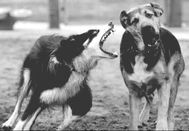
Rabies
Rabies affects all mammals (warm blooded animals with backbones that produce milk and have fur or hair) including dogs and humans.
Rabies was eradicated from all UK animals except bats in 1922. The last case in an imported animal outside of quarantine was in 1970.
How to spot rabies
If a mammal that you own is bitten or scratched by a bat, or another animal that may be rabid, consult a vet.
How rabies is spread
Rabies is present in the saliva of infected animals and is usually spread by the bite of an infected animal.
Rabid saliva can also infect open wounds or mucous membranes such as the nostrils, mouth and lips, eyelids and ears.
Rabies in bats
Although rabies has been eradicated from the UK, a strain of the disease continues to be present in bats in this country.
Bat rabies, or European bat lyssavirus is very rare among bats in the UK. But if you handle bats regularly you should be vaccinated as a precaution.
If you have not been vaccinated against the disease:
Risk to humans from rabies
You may have been exposed to rabies, if you are bitten or scratched by:
A bat in the UK.
Any mammal in countries where rabies is present in other animals.
If there is a risk you have been exposed to the disease you should:
The disease is fatal for humans once signs of the disease appear. It can only be prevented if you are treated soon after exposure.
Read the NHS guide to rabies for more information about the disease in humans.
Preventing and controlling rabies
Preventing rabies
If you are bringing an animal into the UK you must follow these requirements for pet travel.
If rabies is confirmed
If rabies is confirmed the strategy for dealing with an outbreak of rabies will be implemented.
Rabies affects all mammals (warm blooded animals with backbones that produce milk and have fur or hair) including dogs and humans.
Rabies was eradicated from all UK animals except bats in 1922. The last case in an imported animal outside of quarantine was in 1970.
How to spot rabies
- Early clinical signs of rabies include:
- behaviour changes - friendly animals may become cautious, shy animals may become bold
- in dogs, a tendency to excessively seek attention and lick owners
- hypersensitivity to noise or light
- This can be followed by:
- increased aggression - dogs may try to break free and attack objects, animals and handlers
- eyes taking on a staring expression
- drooping lower jaw and more saliva than normal produced
- itching
- thirst
- The final stages of rabies include:
- weak muscles, especially legs and tail
- difficulty swallowing
- drooping eyelids
- saliva frothing at the mouth
- general paralysis followed by convulsions and coma before death
If a mammal that you own is bitten or scratched by a bat, or another animal that may be rabid, consult a vet.
How rabies is spread
Rabies is present in the saliva of infected animals and is usually spread by the bite of an infected animal.
Rabid saliva can also infect open wounds or mucous membranes such as the nostrils, mouth and lips, eyelids and ears.
Rabies in bats
Although rabies has been eradicated from the UK, a strain of the disease continues to be present in bats in this country.
Bat rabies, or European bat lyssavirus is very rare among bats in the UK. But if you handle bats regularly you should be vaccinated as a precaution.
If you have not been vaccinated against the disease:
- assume that all bats are possible carriers of bat rabies
- avoid touching bats, living or dead, whenever possible
- if you must touch a bat, wear thick gloves to avoid being bitten or scratched
Risk to humans from rabies
You may have been exposed to rabies, if you are bitten or scratched by:
A bat in the UK.
Any mammal in countries where rabies is present in other animals.
If there is a risk you have been exposed to the disease you should:
- wash your wound thoroughly with soap and water
- disinfect the wound
- immediately contact a doctor for treatment
The disease is fatal for humans once signs of the disease appear. It can only be prevented if you are treated soon after exposure.
Read the NHS guide to rabies for more information about the disease in humans.
Preventing and controlling rabies
Preventing rabies
If you are bringing an animal into the UK you must follow these requirements for pet travel.
- If you suspect rabies
- Do not approach live animals that you think may be rabid.
- Do not touch dead animals that may have had the disease.
- Instead you must immediately tell your nearest APHA office, so the animal can be tested.
If rabies is confirmed
If rabies is confirmed the strategy for dealing with an outbreak of rabies will be implemented.

